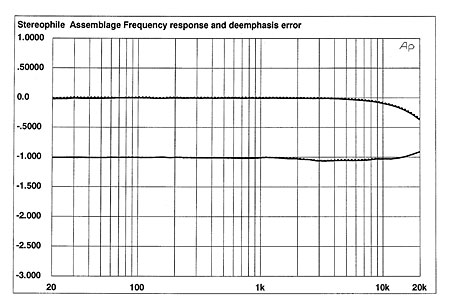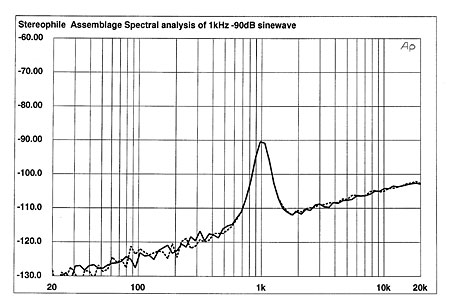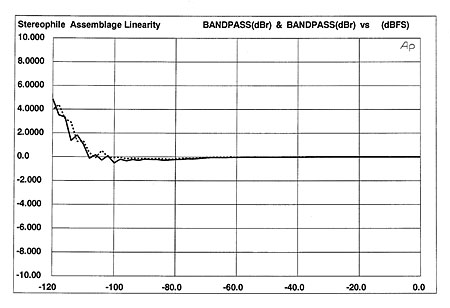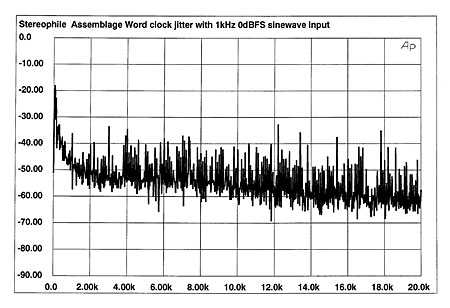| Columns Retired Columns & Blogs |
Parts Connection Assemblage DAC-1 D/A converter kit Measurements
Sidebar 2: Measurements
Footnote 1 See my Follow-Up on the Linn Numerik processor in Vol.17 No.10 for a technical and musical comparison of the Burr-Brown PCM63 and PCM 1702 DACs.—Robert Harley
The Assemblage DAC-1's maximum output level was 1.96V—just under the CD standard of 2V. Output impedance was a low 77 ohms at any audio frequency, and I wasn't able to measure any DC offset at the analog output jacks. The DAC-1 doesn't invert absolute polarity, and had no trouble locking to 32kHz and 48kHz datastreams.
Fig.1 shows the DAC-1's frequency response and de-emphasis error. The response is down 0.35dB at 20kHz—a slightly greater rolloff than the 0.25dB specified in the data sheet. The de-emphasis error was negligible, and about as good as you can get with resistor and capacitor tolerances. The crosstalk performance (fig.2) was also excellent, measuring below –110dB at 1kHz. The left-channel separation decreased to 95dB at 20kHz—not quite as good as the specified 100dB of channel separation across the audioband.

Fig.1 Assemblage DAC-1, frequency response (top) and de-emphasis error (bottom) (right channel dashed, 0.5dB/vertical div.).

Fig.2 Assemblage DAC-1, crosstalk R–L (L–R dashed, 10dB/vertical div.).
A spectral analysis of the DAC-1's output when decoding a 1kHz, –90dB dithered sinewave (fig.3) revealed very low noise, good isolation of the audio circuits from power-supply noise, and excellent DAC behavior.

Fig.3 Assemblage DAC-1, spectrum of dithered 1kHz tone at –90.31dBFS, with noise and spuriae (1/3-octave analysis, right channel dashed).
The DAC-1's linearity (fig.4) was about as good as D/A converters get. A very slight negative error starting at –70dBFS is inconsequential. Note that the Burr-Brown PCM 1702 DACs don't need MSB trimming (footnote 1) and will thus offer this excellent linearity over time and temperature variations. The DAC-1's reproduction of a 1kHz, –90dB undithered sinewave (fig.5) shows good DAC behavior at this low signal level, but with a slightly high level of audioband noise. The noise-modulation performance (fig.6) was excellent, with tight trace groupings. This performance isn't quite as good, however, as that seen in the Sonic Frontiers SFD-2 Mk.II (see fig.8 in my Follow-Up on the SFD-2 in March, Vol.18 No.3, p.138). There's also an odd peak in the noise floor at 2kHz.

Fig.4 Assemblage DAC-1, departure from linearity (right channel dashed, 2dB/vertical div.).

Fig.5 Assemblage DAC-1, waveform of undithered 1kHz sinewave at –90.31dBFS.

Fig.6 Assemblage DAC-1, noise modulation, –60 to –100dBFS (10dB/vertical div.).
The intermodulation spectrum, generated by performing an FFT on the DAC-1's output while it decodes data representing a full-scale mix of 19kHz and 20kHz tones (fig.7), shows very few IM products. The 1kHz difference product is very low in level, as are the sidebands around the test signal.

Fig.7 Assemblage DAC-1, HF intermodulation spectrum, DC–22kHz, 19+20kHz at 0dBFS (linear frequency scale, 20dB/vertical div.).
Looking next at the DAC-1's clock jitter (measured with the Meitner Analyzer at the 8x-oversampling word-clock input on the PCM 1702 DACs), I measured an RMS jitter value (over a 400Hz–22kHz bandwidth) of 175 picoseconds with a 1kHz full-scale input signal. The jitter spectrum, shown in fig.8, isn't that clean, with many periodic components (including strong signal-correlated components apparent at 1kHz and 3kHz). With an input signal of all zeros, the RMS jitter decreased to 110ps, and the spectrum was much cleaner (not shown). With a low-level test signal of a 1kHz, –90dB sinewave, the spectrum was moderately clean (fig.9), with only strong jitter components at 1kHz and 2kHz. The RMS level, however, increased to 285ps. These measurements suggest that the DAC-1 will be sensitive to transport quality.

Fig.8 Assemblage DAC-1, word-clock jitter spectrum, DC–20kHz, when processing 1kHz sinewave at 0dBFS (linear frequency scale, 10dB/vertical div., 0dB=1ns).

Fig.9 Assemblage DAC-1, word-clock jitter spectrum, DC–20kHz, when processing 1kHz sinewave at –90dBFS (linear frequency scale, 10dB/vertical div., 0dB=1ns).
The DAC-1's bench performance was excellent for any processor, let alone one costing $449.—Robert Harley
Footnote 1 See my Follow-Up on the Linn Numerik processor in Vol.17 No.10 for a technical and musical comparison of the Burr-Brown PCM63 and PCM 1702 DACs.—Robert Harley
- Log in or register to post comments



































